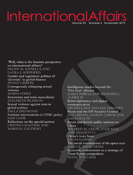-
PDF
- Split View
-
Views
-
Cite
Cite
J. E. Spence, The Royal College of Defence Studies 1927–2017: ninety years of preparing strategic leaders, International Affairs, Volume 95, Issue 6, November 2019, Pages 1454–1455, https://doi.org/10.1093/ia/iiz233
Close - Share Icon Share
Better an educated soldiery than ‘a rapacious and licentious one’. This gloss on Edmund Burke's 1783 admonition might seem a fitting definition of the role of the Royal College of Defence Studies (RCDS) both in the evolution of military doctrine and as a clear demonstration of British soft power at its best. Established in 1927 as the Imperial Defence College, it became the Royal College of Defence Studies in 1972, having moved to an elegant, freestanding and well-equipped house in London's Belgrave Square. Currently, some 150 members, equally divided between British and overseas counterparts, attend a year-long course of intense reflection and debate on major issues of world affairs. The book opens with a well-informed foreword from former Chief of the Defence Staff Air Chief Marshal Sir Stuart Peach and a helpful commentary from Sir Tom Phillips, Commandant at the time of publication.
We owe a considerable debt to Andrew Stewart (until recently Academic Studies Director to the college) for his absorbing study of the college's role in British military education over the last 90 years. He outlines in helpful detail the history of the college, delving profitably into its archive and demonstrating how the key incentive behind its foundation was the pressure to learn from past experience. Thus in May 1920 Earl Curzon, then foreign secretary, argued that the First World War ‘differed from all previous British wars, indeed from all previous wars in scale and character’ (p. 11). Hence the need, according to Winston Churchill, for a ‘common staff brain’ (p. 14) embedded in an institution to train a ‘body of officers and civilian officials in the broadest aspects of imperial strategy … with the instructional staff … drawn from the three fighting services’ (p. 20). Another key figure in the early history of the college was the indefatigable Sir Maurice Hankey, the long-serving Secretary of the Committee of Imperial Defence. It was he who advised Churchill about the composition of the committee established in 1922 to consider the creation of a Joint Staff College (p. 14).
The author has many interesting things to say about the college's role over nearly a century's activity, particularly debates over the length, academic substance and impact of the course of instruction and its rigorous scope and intensity. The college's reputation is such that it has never had difficulty in attracting experts in a variety of relevant fields. Emphasis is placed on regional and country studies, together with analysis of diplomatic theory and practice and the problems of economic and social development. The resulting debate is thus a genuine learning experience for all concerned. The course also enhances Britain's reputation abroad. What must be stressed is that a decent military education requires not only an appreciation of the incentives and constraints governing the making and implementation of strategy and tactics, but also some better understanding of the ideological climate governing a state's aspirations at home and abroad. And this must involve a careful examination of a country's political and diplomatic machinery, its military capability and capacity for efficient decision-making.
The RCDS programme meets these crucial determinants of policy; those who have had the good fortune to attend the college have an unparalleled opportunity to think, read, write and talk to each other. And these skills matter, given that the members are perceived to be capable of high office whether military or civilian; better still is the prospect that many graduates will find themselves cooperating on peacekeeping or peace-making missions and the hope must be that a year's study at the college will make that cooperation easier and more productive. Where else, for example, would, say, senior officers from India and Pakistan or their counterparts in China and the United States find such an agreeable but nonetheless stimulating atmosphere for serious interaction and a better understanding of each other's national aspirations?
Stewart deserves congratulation for producing a work of considerable interest and value to both practitioners of the military arts and those who work in academia and defence journalism.



